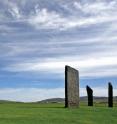Astronomy shown to be set in standing stone
University of Adelaide research has for the first time statistically proven that the earliest standing stone monuments of Britain, the great circles, were constructed specifically in line with the movements of the Sun and Moon, 5000 years ago. The research, published in the Journal of Archaeological Science: Reports, details the use of innovative 2D and 3D technology to construct quantitative tests of the patterns of alignment of the standing stones.
"Nobody before this has ever statistically determined that a single stone circle was constructed with astronomical phenomena in mind - it was all supposition," says project leader and University of Adelaide Visiting Research Fellow Dr Gail Higginbottom, who is also a Visiting Research Fellow at the Australian National University.
Examining the oldest great stone circles built in Scotland (Callanish, on the Isle of Lewis, and Stenness, Isle of Orkney -- both predating Stonehenge's standing stones by about 500 years), the researchers found a great concentration of alignments towards the Sun and Moon at different times of their cycles. And 2000 years later in Scotland, much simpler monuments were still being built that had at least one of the same astronomical alignments found at the great circles.
The stones, however, are not just connected with the Sun and the Moon. The researchers discovered a complex relationship between the alignment of the stones, the surrounding landscape and horizon, and the movements of the Sun and the Moon across that landscape.
"This research is finally proof that the ancient Britons connected the Earth to the sky with their earliest standing stones, and that this practice continued in the same way for 2000 years," says Dr Higginbottom.
Examining sites in detail, it was found that about half the sites were surrounded by one landscape pattern and the other half by the complete reverse.
"These chosen surroundings would have influenced the way the Sun and Moon were seen, particularly in the timing of their rising and setting at special times, like when the Moon appears at its most northerly position on the horizon, which only happens every 18.6 years," Dr Higginbottom says.
"For example, at 50% of the sites, the northern horizon is relatively higher and closer than the southern and the summer solstice Sun rises out of the highest peak in the north. At the other 50% of sites, the southern horizon is higher and closer than the northern, with the winter solstice Sun rising out of these highest horizons.
"These people chose to erect these great stones very precisely within the landscape and in relation to the astronomy they knew. They invested a tremendous amount of effort and work to do so. It tells us about their strong connection with their environment, and how important it must have been to them, for their culture and for their culture's survival."
Source: University of Adelaide
Other sources
- People Were Tracking Celestial Events 5,000 Years Ago, Stone Circles Revealfrom Space.comThu, 18 Aug 2016, 22:31:14 UTC
- Astronomy shown to be set in standing stonefrom Science BlogWed, 17 Aug 2016, 17:51:14 UTC
- Researchers confirm astronomical nature of ancient Scottish stonesfrom UPIWed, 17 Aug 2016, 16:02:41 UTC
- Astronomy Shown to Be Set in Standing Stonefrom Newswise - ScinewsWed, 17 Aug 2016, 11:21:09 UTC
- Researchers validate ancient astronomical structuresfrom PhysorgWed, 17 Aug 2016, 9:31:21 UTC

